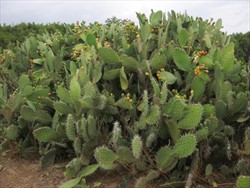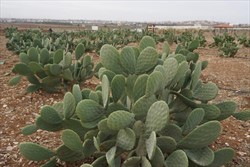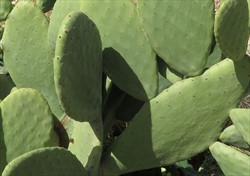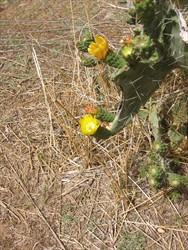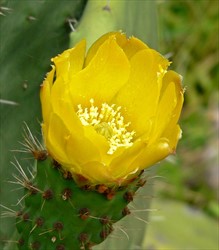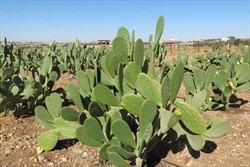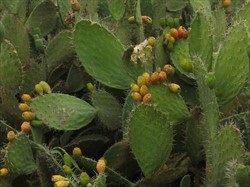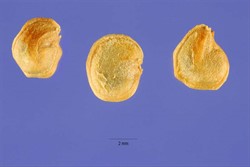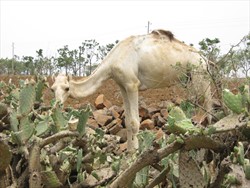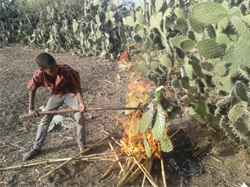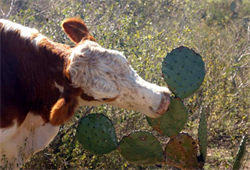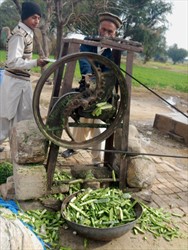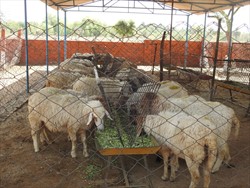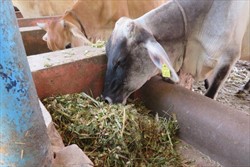Tropical Forages
Basionym: Cactus ficus-indica L.; Cactus decumanus Willd.; Opuntia albicarpa Scheinvar; Opuntia amyclaea Ten.; Opuntia cordobensis Speg.; Opuntia decumana (Willd.) Haw.; Opuntia ficus-barbarica A. Berger; Opuntia ficus-indica var. gymnocarpa (F.A.C. Weber) Speg.; Opuntia gymnocarpa F.A.C. Weber; Opuntia hispanica Griffiths; Opuntia joconostle F.A.C. Weber ex Diguet; Opuntia maxima Mill.; Opuntia megacantha Salm-Dyck; Opuntia paraguayensis K. Schum.
Family: Cactaceae subfamily: Opuntioideae tribe: Opuntieae.
A slow-growing, succulent, segmented cactus, up to 5‒7 m high with a crown of over 3 m in diameter; with age developing a trunk up to 1 m diameter; superficially spreading root system. Branches (cladodes) are flattened, obovate to oblong, 20‒60 cm long × 10‒40 cm wide, grey to grey-green; terminal cladodes always bright green, producing flowers and new growth; younger branches arching upwards. Leaves are generally reduced to few spines (to 2.5 cm long) on young cladodes and shed early; some varieties are spineless. Flowers located on the perimeter of the cladodes, conspicuous, yellow or orange, cup-shaped, 6‒7 cm long × 5‒7 cm wide; petaloids spreading, obovate to oblong-obovate, 2.5-3.5 × 1.5-2 cm, margin entire or erose, apex rounded, truncate, mucronate, or emarginate. The fruit is an oblong berry, 5‒10 cm long × 4‒9 cm wide, green at first ripening to yellow, orange, red or purple in colour (variety dependent), covered with clusters of minute spines. Number of viable seeds per fruit varies from 177 to 357.
Note: Cultivated O. ficus-indica forms are generally spineless, referred to by some as "var. inermis" or "forma Inermis". However, this is not a stable feature; formation of spines can be environmentally influenced.
English: Barbary-fig, cactus pear, Indian-fig, Indian-fig prickly-pear, mission cactus, mission prickly-pear, prickly-pear, smooth mountain prickly-pear, smooth prickly-pear, spineless cactus, sweet prickly-pear, tuberous prickly-pear, tuna cactus, yellow prickly pear
Africa: boereturksvy, doringblaar, grootdoringturksvy, kaalblaar, turksvy (Afrikaans); beles (Arabic, Eritrea, Ethiopia); idolofiya (Ndebele); mudorofia, munanazi (Shona)
Asia: 梨果仙人掌 li guo xian ren zhang (China)
Indian subcontinent: hathlo thor, chorhthlo (Gujarati); haththathoira, nagphana, नागफनी नंदी इंडिका naagphnii, nagphani (Hindi); snuhi, vajrakantaka, bahushala (Sanskrit); nagadali, nagakkali, chapati balli (Tamil); nagamulla, nagajemudu (Telugu); nagphani, thuar (Urdu)
Europe: schijfcactus, vijgcactus (Dutch); figuier de Barbarie, figuier d'Inde, raquette (French); Figenkaktus, gelbe/grüne Kaktusfeige, indischer Feigenkaktus (German); fico d'India, pero pungente (Italian); fikonkaktus (Swedish)
Portuguese/Brazil: figo-da-Espanha, figo-da-Índia, figueira-da-Barbária, jamaracá, jurumbeba, orelha-de-onça, palma-de-gado, palma-gigante
Spanish/Spanish America: chumba, chumbera, higuera, nopal de Castilla, nopal pelón, tuna, tuna de Castilla, tuna mansa; nochtli (Mexico)
Native:
Probable origin Mexico.
Cultivated/naturalized:
Macaronesia: Cape Verde, Madeira Islands, Canary Islands
Africa: Angola, Eritrea, Ethiopia, Kenya, Libya, Morocco, South Africa, Tunisia
Asia: Saudi Arabia, Yemen, Cyprus, Lebanon, Syria, Turkey, China (s.)
Australasia & Pacific: Australia, Hawaii
Europe: Greece, Italy, France (incl. Corsica), Spain (incl. Baleares)
Northern America: USA (Arizona, California); Mexico
Central America & Caribbean: Cuba, Guadeloupe, Hispaniola, Netherlands Antilles, Nicaragua, Puerto Rico, Trinidad and Tobago (Trinidad)
South America: Argentina, Bolivia, Brazil, Ecuador, Paraguay
Forage
O. ficus-indica is used for feeding various classes of livestock, including dairy cattle. In low rainfall countries it is a valuable source of energy and often water, although protein levels are low. It can provide up to 180 t H2O/ha/yr stored in its tissue for livestock watering.
Environment
It is used in alley-cropping systems, in contour hedgerows for soil erosion control, and in rows as a windbreak. It can be used for land reclamation by virtue of its ease of establishment on degraded lands, and can improve soil fertility through cycling of nutrients and organic matter accumulation.
O. ficus-indica is the most widespread and most commercially important cactus, and has been/is being widely introduced as a commercial fruit and vegetable (nopalitos) crop, more recently as part of forestry or agroforestry projects in developing countries. The thorny varieties are often used as defensive hedges. It is also one of the cactus hosts for the cochineal insect (Dactylopius coccus Homoptera: Dactylopiidae) used in the production of cochineal dyes.
O. ficus-indica is native to regions with a sub-tropical to warm temperate climate typically with summer rains and cool and dry winters. It is naturalized and cultivated throughout the arid and semi-arid zones of the tropics and subtropics, including warm-temperate climates.
Soil requirements
Requires well-drained soils (with <15‒20% clay content); adapted to a wide pH range; highest potential on fertile soils; able to grow on shallow and rocky substrates due to superficially spreading root system; no tolerance of salinity.
Moisture
Grows in an annual rainfall range of (150‒) 250‒800 (‒1,200) mm with 5‒8 dry months. Adaptation to low rainfall is partly due to the CAM (Crassulacean acid metabolism) photosynthetic pathway. Water use efficiency is 3‒5 times higher than in C4 and C3 plants.
Temperature
Grows in regions with hot summers (mean maximum temperatures of 35‒38 °C in the hottest month) and cool winters (mean minimum temperatures of 7‒12 °C in the coldest month); survives <0 °C for brief duration. Nights should be cold.
Light
No shade tolerance.
Reproductive development
Flowering occurs on 1‒2 yr-old cladodes. Reproduction is both sexual and vegetative; 10.9‒18.5% of apomixis have been reported. For plantations, O. ficus-indica is vegetatively propagated (cladodes as propagative material). Plantations are exploitable after 3‒4 years and fully grown after 7‒10 years; can remain productive for >50 years under rational management.
Defoliation
Management (e.g. in terms of residual photosynthetic area after cutting) is necessary for sustainable production; depending on input level, harvests every 1‒4 years possible.
Fire
Fire is used as one of the tools to control stands of O. ficus-indica if the species is becoming invasive.
Guidelines for establishment and management of sown forages.
Establishment
O. ficus-indica is, in general, vegetatively established (cladodes as propagative material). For rehabilitation/improvement of native rangeland, recommended density of 1,000‒2,000 single or double cladodes per ha, with a spacing of 5‒7 m between rows and 1‒2 m within rows. For alley cropping, wide rows (e.g. 10‒15 m) with the crop in the interspace. Initial weed control necessary.
Fertilizer
In spite of thriving particularly well on good soils, fertilization is applied only in intensively managed plantations, e.g. including fertigation. Exported nutrients (kg/ha/yr), based on 20 t harvested DM/ha/yr, are about 180 kg N, 32 kg P, 516 kg K and 470 kg Ca and must be replaced by fertilization if the system is to be sustainable. Organic fertilizer is reported to be particularly effective. Fertilization with N has been reported to increase CP content.
Compatibility (with other species)
During establishment phase, susceptible to competition by weeds.
Companion species
Legumes: Gliricidia sepium, Leucaena leucocephala and Prosopis juliflora for alley-cropping in Northeast Brazil. Suitable for alley cropping with maize, barley and sorghum.
Pests and diseases
A number of region-dependent fungal and bacterial diseases are reported for O. ficus-indica, also phytoplasmas. Their potential thread to forage plantations appears to be only little studied however. Among insects pests, cottony cochineal (Dactylopius opuntiae Homoptera: Dactylopiidae) is considered as the most important pest. The cladodes of young plants are susceptible to attack by the cactus moth (Cactoblastis cactorum Lepidoptera: Pyralidae), the biological control agent responsible for the near-eradication of the environmental weed Opuntia in parts of Australia.
Ability to spread
Dispersal by seed through animals; also via vegetative propagation.
Weed potential
Discussion on the weed potential of O. ficus-indica is controversial. The species is considered a landscape transformer as it displaces indigenous species and dependent animals. In some countries (e.g. South Africa and most Australian states) it is listed as a noxious weed, but in other arid and semiarid areas, it is considered a valuable species because of its multi-use potential, provided management is appropriate.
Nutritive value
Nutritive value decreases with age of cladodes; concentrations of fibre und crude protein are reported to be low (CP 3‒5%, but properly fertilized >10% is possible); high concentrations of digestible carbohydrates. IVDMD around 75%. Very high water content (80‒95%). It is a good source of vitamin A, calcium and magnesium, but is low in sodium, potassium and phosphorus.
Palatability/acceptability
Cladodes of spineless forms are highly palatable to livestock. Spiny forms often require treatment such as burning or a mechanical process to remove or pulverize the spines to make the cladodes more acceptable. Camels are able to ingest cladodes with spines intact.
Toxicity
Low amounts of tannins and saponins, also oxalates, have been reported, without affecting livestock production.
Feedipedia links
Dry matter
About 20 to DM ha/yr are frequently reported, but >50 t DM ha/yr have been achieved in intensive cultivation systems (optimum plant density and management including fertilization; northeast Brazil). When rehabilitated with O. ficus-indica, native rangeland productivity can increase several-fold (Tunisia).
Animal production
Supplementing low quality forage with fresh O. ficus-indica increases the average daily gain of growing ruminants, particularly when N is added. In diets of dairy cows and dairy goats, a considerable portion of concentrates can very economically be substituted by O. ficus-indica.
2n = 22; cultivated forms may be octoploids (2n = 88) or hexaploids (2n = 66). Triploids (2n = 33), tetraploids (2n = 44) and pentaploids (2n = 55) have also been identified. There are breeding programs (including hybridization with other Opuntia species), part of which also focus on forage production, in Mexico, Brazil, Italy and USA. Main selection criteria for forage types are improved nutritional content, frost tolerance, spineless cladodes, high productivity and quick recovery after pruning, wider adaptability (especially to tropical dry & heat), adaptation to intensive production systems, and pest and disease tolerance.
Though establishment of O. ficus-indica is mainly by vegetative propagation, seed production is possible; after initial dormancy (scarification necessary), maximum germination occurs after 9 months.
Pre-emergence herbicides, Diuron, Tebuthiuron, or a combination of Simazine and Ametryne, are effective for weed control at establishment. To combat O. ficus-indica when it becomes invasive, a combination of chemical, mechanical (incl. fire) and biological controls has been suggested.
- Very high water use efficiency.
- Multipurpose species.
- High water content (drinking requirements of livestock).
- High DM production potential.
- Invasive weed potential.
- Low contents of CP and fibre.
- High water content (transportation costs).
- Supplement to other feedstuff only.
Abay, N.G. (2018) Cactus (Opuntia ficus-indica): Current utilization and future threats as cattle forage in Raya Azebo, Ethiopia. Environmental Management and Sustainable Development 7(3):1–13. doi.org/10.5296/emsd.v7i3.12806
Inglese, P., Mondragon, C., Nefzaoui, A., Sáenz, C., Taguchi, M., Makkar, H. and Louhaichi, M. (2017) Crop ecology, cultivation and uses of cactus pear. Food and Agriculture Organization of the United Nations, (FAO), Rome, Italy). hdl.handle.net/20.500.11766/8263
Misra, A.K., Kumar, S., Kumar, T.K., Ahmed, S., Palsaniya, D.R., Ghosh, P.K., Louhaichi, M., Sarker, A., Hassan, S. and Ates, S. (2018) Nutrient intake and utilization in sheep fed opuntia [Opuntia ficus-indica (L.) Mill.] in combination with conventional green and dry fodders. Range Management & Agroforestry 39 (1):97–102. hdl.handle.net/20.500.11766/8565
Mondragón-Jacobo, C. and Pérez-González, S. (eds). (2001) Cactus (Opuntia spp.) as Forage. FAO Plant Production and Protection Paper No. 169. Food and Agriculture Organization of the United Nations (FAO), Rome, Italy. fao.org/3/Y2808E/y2808e00.htm
Pasiecznik, N. (2007) Datasheet for Opuntia ficus-indica (prickly pear). CABI Invasive Species Compendium, Wallingford, Oxon, UK. cabi.org/isc/datasheet/37714
'Palma Gigante', 'Palma Redonda', 'Orelha de elefante', 'Mexicana', 'IPA-Clone 20' Released in Brazil
'CPF1', 'CPF2', 'CPF3', 'ANF1', 'ANV1', 'Pabellón' Released in Mexico
'Zukini' Origin unknown; a red-fruited spineless cultivar
'Burbank Spineless', 'Sweet Emerald', 'Sweet Crimson', 'Sweet Purple', 'Sweet Sunset' Released in USA
Much of the selection is based on fruit quality.
None reported.
